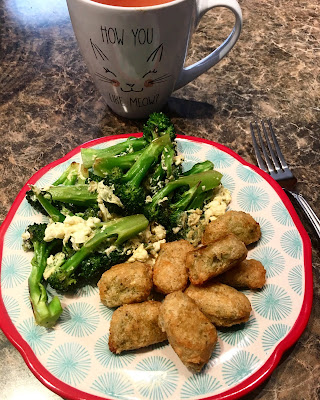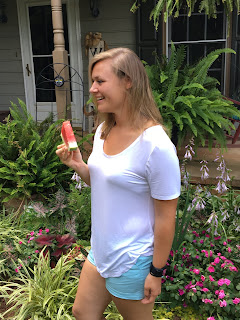Pickin' Up Pawpaws
Put 'em in your pocket...
Texture like a ripe avocado, mouthfeel of a banana, and taste of mixed tropic fruit, this "hillbilly mango" is native to 26 states in North America ranging from northern Florida all the way up to Ontario, Canada and go as far west as Nebraska.
Also called the "poor man's banana", this indigenous fruit provided nutrient dense food for wild animals, Native Americans, and even European explorers and settlers back in the day. Pawpaws are still cropped in the US today and enjoyed in many rural areas. They bloom in the spring and then harvested in late August through mid October, making pawpaws a seasonal fall crop.
Several years ago, my father planted some pawpaw trees on his farm in Western North Carolina, and this year they are producing gobs of fruit. The first time I tried a pawpaw, I did not really know what to think...the texture was like a very ripe avocado but flavor was like an earthy banana with a faint taste of mango and blueberry...weird combo, right? It is by no means a favorite fruit of mine (doesn't even make my top 10), but it is still fascinating to learn about fruits our ancestors cultivated and ate for proper nutrition.
That brings me to the nutrient facts of a pawpaw! Pawpaws are fruit, so they are full of similar nutrients like a banana, however they are higher in protein and fat content. One pawpaw has 80 calories, 1.2 grams of fat, 18.8 grams of carbohydrate, and 2.6 grams of dietary fiber.
Pawpaws contain 1.2 grams of complete protein...that's right! Pawpaws contain all of the essential amino acids our bodies need. Pawpaws are one of the few plants that contain all essential amino acids. Other complete protein plants include soy and quinoa...that is what makes this fruit so unique and interesting!
Now, of course you can eat this fleshy plant raw off the tree, but there are numerous other ways to utilize this fruit! The fruit is ripe when it becomes soft on the tree and can be eaten right away or stored in a refrigerator up to one week. It is a little difficult to process as it contains many big, black seeds, but I found that peeling the fruit with a knife and pressing it through a strainer works well. At that point, you can use the flesh in baked goods or freeze it for a later use. Because the fruit is naturally fatty and creamy, it would make a great base for a smoothie or custard.
When my dad gave me pawpaws last week, I had to get in the kitchen and experiment! I ended up making "Pawpaw-Nut Muffins" with the recipe below. Try it out and let me know how ya like 'em!
Pawpaw-Nut Muffins
Ingredients
Until next time,
Texture like a ripe avocado, mouthfeel of a banana, and taste of mixed tropic fruit, this "hillbilly mango" is native to 26 states in North America ranging from northern Florida all the way up to Ontario, Canada and go as far west as Nebraska.
Also called the "poor man's banana", this indigenous fruit provided nutrient dense food for wild animals, Native Americans, and even European explorers and settlers back in the day. Pawpaws are still cropped in the US today and enjoyed in many rural areas. They bloom in the spring and then harvested in late August through mid October, making pawpaws a seasonal fall crop.
Several years ago, my father planted some pawpaw trees on his farm in Western North Carolina, and this year they are producing gobs of fruit. The first time I tried a pawpaw, I did not really know what to think...the texture was like a very ripe avocado but flavor was like an earthy banana with a faint taste of mango and blueberry...weird combo, right? It is by no means a favorite fruit of mine (doesn't even make my top 10), but it is still fascinating to learn about fruits our ancestors cultivated and ate for proper nutrition.
That brings me to the nutrient facts of a pawpaw! Pawpaws are fruit, so they are full of similar nutrients like a banana, however they are higher in protein and fat content. One pawpaw has 80 calories, 1.2 grams of fat, 18.8 grams of carbohydrate, and 2.6 grams of dietary fiber.
Pawpaws contain 1.2 grams of complete protein...that's right! Pawpaws contain all of the essential amino acids our bodies need. Pawpaws are one of the few plants that contain all essential amino acids. Other complete protein plants include soy and quinoa...that is what makes this fruit so unique and interesting!
Now, of course you can eat this fleshy plant raw off the tree, but there are numerous other ways to utilize this fruit! The fruit is ripe when it becomes soft on the tree and can be eaten right away or stored in a refrigerator up to one week. It is a little difficult to process as it contains many big, black seeds, but I found that peeling the fruit with a knife and pressing it through a strainer works well. At that point, you can use the flesh in baked goods or freeze it for a later use. Because the fruit is naturally fatty and creamy, it would make a great base for a smoothie or custard.
When my dad gave me pawpaws last week, I had to get in the kitchen and experiment! I ended up making "Pawpaw-Nut Muffins" with the recipe below. Try it out and let me know how ya like 'em!
Pawpaw-Nut Muffins
Ingredients
- 1/3 cup pitted and chopped dates
- 1/3 cup unsweetened dried cranberries
- 1 cup unsweetened applesauce
- 3 tablespoons of honey
- 1 cup water
- 1 cup old fashioned oats
- 1 cup of all purpose flour
- 2 eggs
- 1 teaspoon baking soda
- 1/2 cup smashed pawpaw fruit (1 large pawpaw)
- 3/4 cup of nuts (I used English walnuts)
- baking spray
Directions:
- In a saucepan, add water, dates, and cranberries and bring to boil. Stir in applesauce and honey and allow to boil for 1-2 minutes. Set aside to cool.
- In a blender, pulse together the oats, AP flour, eggs, baking soda, and nuts--roughly. Then pour into a mixing bowl and combine together well, making a dough-like texture.
- Mix in the cooled applesauce mixture and pawpaws to dough. Put in refrigerator for 15-30 minutes.
- Spray muffin tins and fill with batter 3/4 of the way up, allowing room to rise. Bake at 350 degrees for 25-35 minutes or until cooked all the way through.
What do you think? Are you curious to try a pawpaw now? Check your local farmer's market to see if they've got any in stock and let me know how you like them!
Until next time,
Happy Chewing!
Katrina Detter, RD
Katrina Detter, RD
Registered Dietitian Nutritionist
Follow me on Social Media!
Facebook: Live Better with Kat Detter
Facebook: Live Better with Kat Detter
Instagram: @betterwithkatdetter_rd
References:
Cooking with Pawpaws. Axonopus affinis. hort.purdue.edu/newcrop/ksu-pawpaw/cooking/html. Accessed September 9, 2018.








Comments
Post a Comment